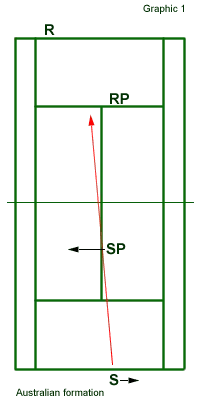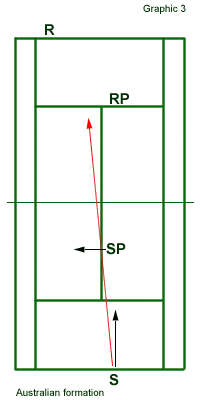This is a tactic used by the serving team only, where they start the point with both players on the same side of their court.
Example: Server positions on the deuce side (close to the center mark) and his partner (at the net) is on the deuce side also (close to the center line) - see the following graphic:

Reasons why you should use the AF:
1. It takes away the element of predictability from the returner – since most players are used to returning cross-court, having the net player positioned at the cross-court path makes the returner reconsider this option.
2. If the server has a weak side, for example, the backhand… when serving from the ad side, the server’s partner (at the net) positioning at the same side as the server covers the cross-court serve return (server’s backhand). That forces the serve receiver to hit the ball down-the-line which is the server’s forehand (strong side). Of course, we are assuming that the server will switch sides (to deuce) as soon as his serve is in.
Having said that, the AF is a strategy mainly used to put pressure on the serve returner.
It is very important for the server and his partner to communicate, in advance, their tactic that will follow the serve delivery. One of them should switch positions right after the serve has been delivered. So the server can switch to cover the open court or stay put and have the net player switch to cover the opening. This has to be planned before the point begins.
They must be careful not to switch too early. By moving before the ball touches the court the receiver has time to plan his delivery. But if they wait to move until just before the receiver contacts the ball it will be too late for a return change in plan. Ideally, the switch should be done sometime between the ball bounce and the returner hitting it.
How does the Australian formation put pressure on the serve returner?
1. It takes away the comfort of planning the return. Having two players positioned cross-court, the obvious target for the returner would be a down-the-line return. But he can’t be sure that the net opponent will not cover that side. The returner will then just take a guess aiming either cross-court or down-the-line hoping that his shot will not be poached by the opposing up player.
2. By having to go to the obvious opening (down-the-line) where the net is higher (6 inches), the probability of hitting the net is greater. Also, by going down-the-line, the court is shorter.
3. Mechanically, going down-the-line is harder than the cross-court option for the simple fact that changing the direction of the ball is not always easy.
How to Use the Australian Formation
– Server (S) stays; net player (SP) switches (see graphic 1 below)

The serve should be placed as close as possible to the center (T) or into the receiver’s body. That takes the angles away from the returner and the server’s net partner will be in a good position to poach.
Avoid the wide serve since it would be very difficult for the server’s net partner to cover the alley in time.
– Server (S) switches; net player (SP) stays (see graphic 2 below)

The into-the-body or slightly wide serve would be the better choice because it gives the server more time to cross over to the other side and cover the alley if necessary.
– Server moves up to the net; net player switches (graphic 3 below) - hit the serve down-the-T or toward the receiver's body:

– Server switches and moves up to the net (across); the net player stays (graphic 4 below)

The server should send the ball toward the receiver’s body. Avoid the wide serves since they open the court down the alley or between the players (the Gap).
This tactic should not be used too often since it is very difficult to cover the court when the server approaches cross-court. Use it as a distraction or to add variety.
Last (but not least)… the net player should use the fake poach often to confuse the serve returner.
Example: If the net player’s tactic is to stay put and have his serving partner switch, the net player should fake an intention to cross over to poach right after the ball bounces on the other side. This move not only masks the server’s action (switch) but confuses the returner too.